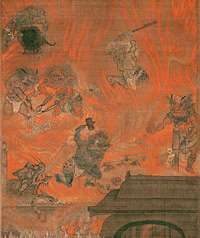Avīci
In Buddhism, Avīci or Avici (Sanskrit and Pali for "without waves" – Chinese and Japanese: 無間地獄 Wújiàn dìyù/Mugen jigoku or 阿鼻地獄 Ābí dìyù/Abi jigoku; Burmese: အဝီစိငရဲ) is the lowest level of the Naraka or "hell" realm, with the most suffering, into which the dead who have committed grave misdeeds may be reborn.[1] It is said to be a cube 20,000 yojanas (240,000 to 300,000 kilometers) to a side, buried deep underneath the divine (nonvisible) earth.[2] Avīci is often translated into English as "interminable" or "incessant", referring to suffering without periods of respite, although it is believed to be ultimately impermanent.[3]
| Avīci | |||||||||||||
|---|---|---|---|---|---|---|---|---|---|---|---|---|---|
| Chinese name | |||||||||||||
| Traditional Chinese | 無間地獄 | ||||||||||||
| Simplified Chinese | 无间地狱 | ||||||||||||
| |||||||||||||
| Alternative Chinese name | |||||||||||||
| Traditional Chinese | 阿鼻地獄 | ||||||||||||
| Simplified Chinese | 阿鼻地狱 | ||||||||||||
| |||||||||||||
| Burmese name | |||||||||||||
| Burmese | အဝီစိငရဲ | ||||||||||||
| IPA | [a̰wìsḭjɛ́] | ||||||||||||
| Japanese name | |||||||||||||
| Kanji | 無間地獄 | ||||||||||||
| Hiragana | むげんじごく | ||||||||||||
| |||||||||||||
| Sanskrit name | |||||||||||||
| Sanskrit | Avīci | ||||||||||||
| Pali name | |||||||||||||
| Pali | Avīci | ||||||||||||

Avīci-punishable offenses/transgressions
There are various evil acts which can lead one to being committed to the torments of the Avīci hell. People reborn in Avīci have generally committed one or more of the Five Grave Offenses:[3][4]
Details about Avīci
Buddhism teaches that going to Naraka is temporary, allowing the offenders to work off the karma they garnered in life. Avīci is sometimes cited as lasting 3.39738624×1018 or 339,738,624×1010 years,[5] about 3.4 quintillion years.
The Lotus Sutra provides an example of humans who have to endure long-term suffering in Avīci.[6][7] Some sutras state that rebirth in Avīci will be for innumerable kalpas (aeons). When the offending soul passes away after one kalpa, it is reborn in the same place, suffering for another kalpa, and on and on until it has exhausted its bad karma.[8] For this reason, the Avīci hell is also known as the "nonstop way" (無間道).
Nichiren famously wrote that Buddhist monks who ignored the passages in the Lotus Sutra, which claimed superiority over other sutras, would fall into the Avīci hell.[9] Outside of Nichiren, it is extremely rare for a Buddhist monk to condemn anyone to Avīci, although the Lotus Sutra itself states of anyone who slanders it: "when his life comes to an end, he will enter the Avichi Hell."
Some believe rebirth in Avīci (or any lower realm, for that matter) should be seen as a process of purification. If anyone correctly follows the teachings of Buddha, he will be able to attain enlightenment without going to any hell even if he has accumulated a vast amount of negative karma (excluding Anantarika-karma).
There are many stories of people who have accumulated negative karma but avoided all the levels of Naraka because they attained enlightenment before their karma ripened. If one has Anantarika-karma, he will not be able to attain enlightenment in this life because this negative karma will ripen immediately.
There is no supernatural being that determines anyone's fate of its own will;[10] everyone is responsible for his own actions and their consequences: "[...] beings are owners of kamma, heir to kamma, born of kamma, related through kamma, and have kamma as their arbitrator. Kamma is what creates distinctions among beings in terms of coarseness & refinement."[11] Thus, being reborn in Avīci is purely the inevitable result of one's evil deeds and not the decision of a deity.
References
- Gray, David B. (2007). "Compassionate Violence? On the Ethical Implications of Tantric Buddhist Ritual". Journal of Buddhist Ethics. 14: 238–271.
- Sadakata, Akira (1997). Buddhist cosmology: philosophy and origins, Tokyo: Kōsei Pub., p. 47
- Buswell, Robert E. (2003). The Princeton Dictionary of Buddhism. Princeton: Princeton University Press. p. 86.
- Singh, N.K.; Mishra, A.P. (2010). Global Encyclopaedia of Indian Philosophy. Global Vision Publishing House. p. 50. ISBN 8182202949.
- Akhtar Malik (2007). A Survey of Buddhist Temples and Monasteries. Anmol Publications PVT. LTD. p. 50. ISBN 978-81-261-3259-1.
- Phyllis Granoff; Koichi Shinohara (2012). Sins and Sinners: Perspectives from Asian Religions. BRILL. p. 139. ISBN 978-90-04-22946-4. Retrieved 21 September 2013.
- Kubo Tsugunari, Yuyama Akira (tr.). The Lotus Sutra. Revised 2nd ed. Berkeley, Calif. : Numata Center for Buddhist Translation and Research, 2007. ISBN 978-1-886439-39-9, p. 268
- Shengyan (2002). The Sword of Wisdom: Commentaries on the Song of Enlightenment. Elmhurst, N.Y.: Dharma Drum Publications. p.159.
- Mujū Ichien (30 August 1985). Sand and Pebbles: The Tales of Muju Ichien, A Voice for Pluralism in Kamakura Buddhism. SUNY Press. pp. 19–20. ISBN 978-0-88706-060-1. Retrieved 21 September 2013.
- Itivuttaka: This Was Said by the Buddha
- Cula-kammavibhanga Sutta: The Shorter Analysis of Action